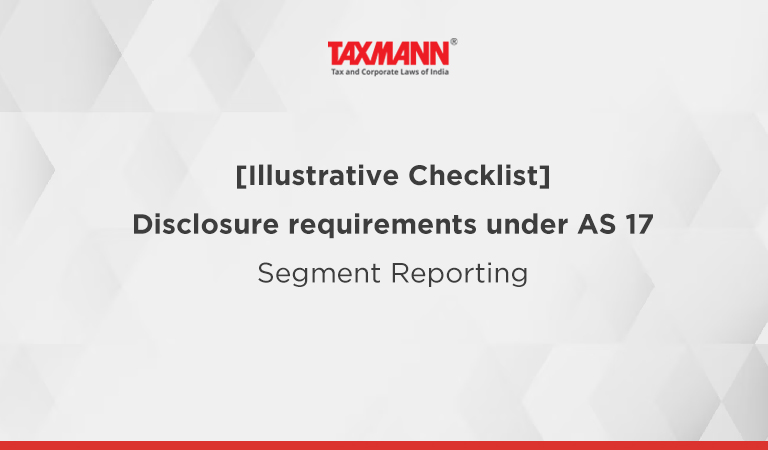[Illustrative Checklist] Disclosure requirements under AS 17 | Segment Reporting
- Blog|News|Account & Audit|
- 2 Min Read
- By Taxmann
- |
- Last Updated on 31 January, 2023

The objective of AS 17, Segment Reporting, is to establish principles for reporting financial information, about the different types of products and services an enterprise produces and the different geographical areas in which it operates. Such information helps users of financial statements, (a) better understand the performance of the enterprise; (b) better assess the risks and returns of the enterprise; and (c) make more informed judgements about the enterprise as a whole. Many enterprises provide groups of products and services or operate in geographical areas that are subject to differing rates of profitability, opportunities for growth, future prospects, and risks. Information about different types of products and services of an enterprise and its operations in different geographical areas – often called segment information – is relevant to assessing the risks and returns of a diversified or multi-locational enterprise but may not be determinable from the aggregated data. Therefore, reporting of segment information is widely regarded as necessary for meeting the needs of users of financial statements.
As per the stipulation of this standard, an entity must comply with the below-mentioned disclosure requirements:
I. Whether the enterprise has disclosed the following for each reportable segment:
a. segment revenue classified into:
i. Sales to external customers
ii. Transactions with other segments
b. Segment result
c. Total carrying amount of segment assets
d. Total amount of segment liabilities
e. total cost incurred during the period to acquire segment assets that are expected to be used during more than period
i. Tangible fixed assets
ii. Intangible fixed assets
f. Total amount of expense included in the segment result for depreciation and amortisation in respect of segment assets for the period
g. Total amount of significant non-cash expenses, other than depreciation and amortisation in respect of segment assets that were included in segment expense and, therefore, deducted in measuring segment result
Click Here To Read The Full Story
Disclaimer: The content/information published on the website is only for general information of the user and shall not be construed as legal advice. While the Taxmann has exercised reasonable efforts to ensure the veracity of information/content published, Taxmann shall be under no liability in any manner whatsoever for incorrect information, if any.

Taxmann Publications has a dedicated in-house Research & Editorial Team. This team consists of a team of Chartered Accountants, Company Secretaries, and Lawyers. This team works under the guidance and supervision of editor-in-chief Mr Rakesh Bhargava.
The Research and Editorial Team is responsible for developing reliable and accurate content for the readers. The team follows the six-sigma approach to achieve the benchmark of zero error in its publications and research platforms. The team ensures that the following publication guidelines are thoroughly followed while developing the content:
- The statutory material is obtained only from the authorized and reliable sources
- All the latest developments in the judicial and legislative fields are covered
- Prepare the analytical write-ups on current, controversial, and important issues to help the readers to understand the concept and its implications
- Every content published by Taxmann is complete, accurate and lucid
- All evidence-based statements are supported with proper reference to Section, Circular No., Notification No. or citations
- The golden rules of grammar, style and consistency are thoroughly followed
- Font and size that’s easy to read and remain consistent across all imprint and digital publications are applied



 CA | CS | CMA
CA | CS | CMA
